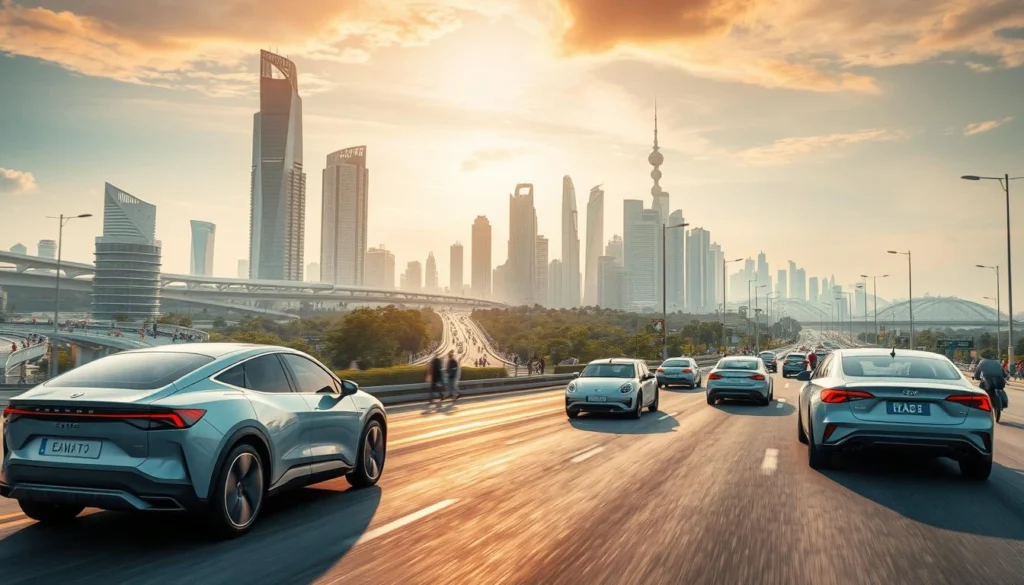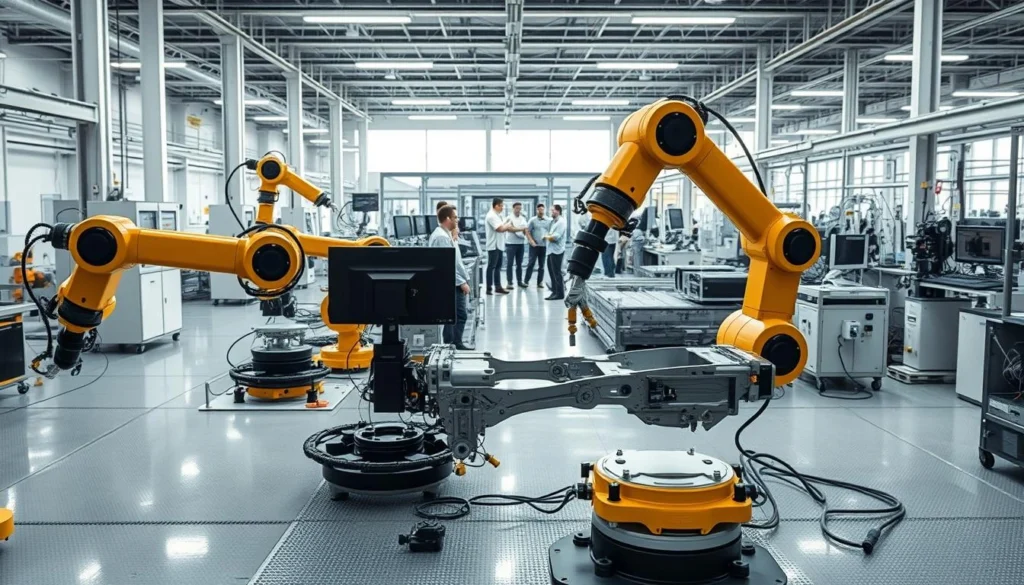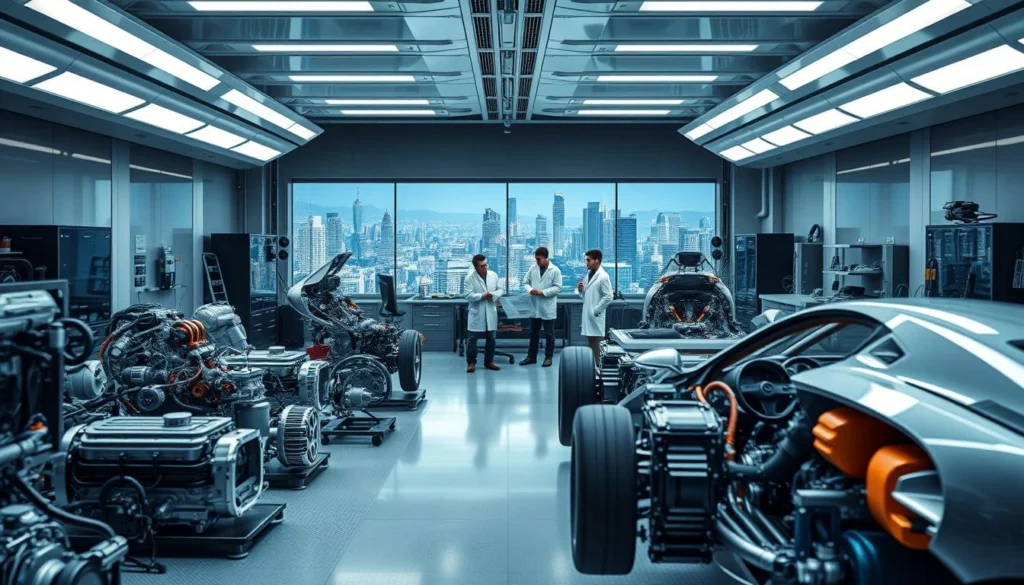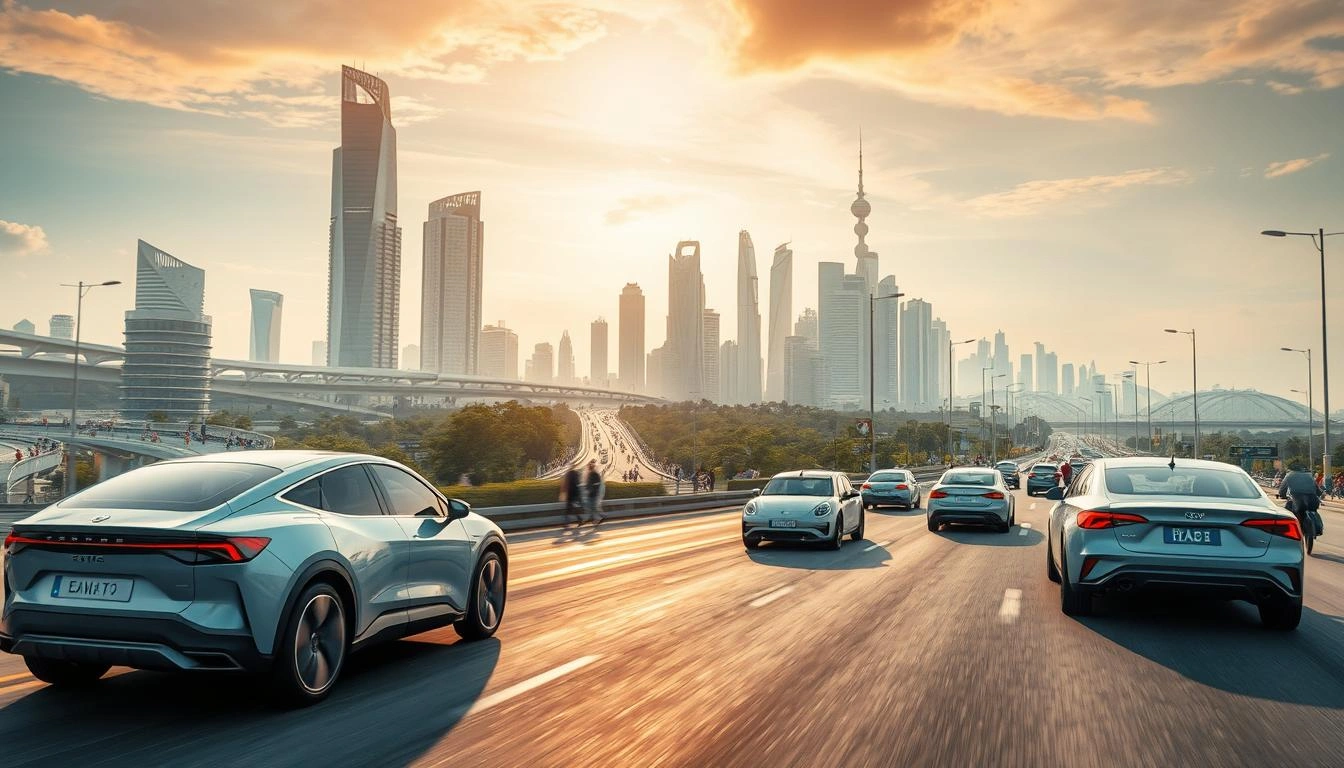
Automotive technology trends: a futuristic cityscape with sleek, autonomous vehicles navigating seamlessly amidst a backdrop of gleaming high-rises and advanced infrastructure. In the foreground, cutting-edge car designs showcase the latest innovations in electric powertrains, intelligent driver assistance systems, and aerodynamic styling. The middle ground features a bustling urban landscape, where pedestrians and cyclists co-exist harmoniously with the autonomous fleet, hinting at the integration of transportation modes. The sky is illuminated by a warm, golden light, conveying a sense of progress and innovation. The overall atmosphere evokes a vision of a sustainable, connected, and technologically-advanced automotive future.
The car industry is changing faster than ever since Henry Ford’s assembly line in 1913. By 2024, cars will be like “computers on wheels,” thanks to software-defined vehicles (SDVs). Governments are setting tough targets for 2030, making electric vehicles a top priority worldwide.
Chinese car makers aim to lead the global market by 2025. This will change how competition works around the world.
Car tech is changing everything in the industry. EV incentives are influencing what people buy. Dealers are using video cameras during repairs to build trust.
Buying a car used to take three days. Now, it can happen in just three hours. Buyers want fast and clear deals. Keeping up with these tech changes is crucial for anyone involved in the future of cars.
Key Takeaways
- 2024 is a key year for car tech, with SDVs and EVs leading the way.
- Global targets are pushing car makers to focus on electric cars and software updates.
- Car tech now includes tools like video feeds at dealerships for real-time tracking.
- EV incentives and better navigation systems are changing how people choose cars.
- Reports like the Automotive OS for SDV guide the move towards smarter, connected cars.
The Evolution of Automotive Tech in the 21st Century
Automotive tech has changed how we see cars. They’re now more about software and connectivity than just engines and metal. Today’s cars use automobile technologies to connect with the world around them. They’ve become like smartphones on wheels, running on code and data.
From Mechanical to Digital: A Paradigm Shift
In the early 2000s, Bluetooth and GPS started changing things. By 2010, Tesla showed how cars could get better with updates. Now, cars use AI for smarter driving and checking health.
Companies like Honda are teaming up with tech firms to make cars even better. This partnership is making in-car systems more advanced.
Key Milestones in Automotive Technology Development
- 1996: GM EV1 became the first mass-produced electric vehicle
- 1998: Toyota Prius hybrid pioneered emission-cutting tech
- 2003: Volkswagen’s DCT offered smoother gear shifts
- 2012: Electronic Stability Control became mandatory for safety
How COVID-19 Accelerated Industry Transformation
Supply chain disruptions pushed automakers to adopt local production and automation. Remote software updates and digital showrooms became essential as factories paused.
After the pandemic, car makers focused on tech that could withstand challenges. Ford and GM started making batteries in the US to cut down on imports. They also sped up tests for 5G in cars to talk to roads and other vehicles.
Electric Vehicles: Powering the Future of Transportation
Electric vehicles (EVs) are changing how we travel. They use car technology advancements for better efficiency and less harm to the environment. New battery types, like solid-state batteries, are making EVs more appealing. They help solve issues like how far they can go and how much they cost.https://www.youtube.com/embed/I_dPgomkmVI
Battery Technology Breakthroughs
New battery tech is making EVs go further than 300 miles. Solid-state batteries could make EVs charge in under 10 minutes. Big car makers like Tesla and BYD are working on these car technology advancements to meet green goals by 2030.
- Battery lifespan: 12–15 years in moderate climates
- Cost reductions: Prices projected to drop 50% by 2030
- Recycling initiatives: 95% material recovery rates for end-of-life batteries
Charging Infrastructure Development
There are now over 60,000 public charging stations in the U.S. The EU plans to add 15,000 stations weekly by 2030. Fast-charging spots can give 200+ miles in just 20 minutes, thanks to automobile technologies like wireless charging. Companies like Tesla and Electrify America are working with utilities to bring charging to rural areas.
| Year | Charging Stations Growth | Global EV Sales |
|---|---|---|
| 2023 | 60,000+ in U.S. | 14 million |
| 2030 | Target: 1 million+ | Projected 45% of new sales |
The Economic Impact of EV Adoption
Now, EVs make up 18% of global car sales. The U.S. hopes to see 50% of cars be EVs by 2030. Even though EVs cost more upfront, they save money on maintenance and fuel over time. California is giving $7,500 tax credits to help people buy EVs.
But, there are still hurdles. Disputes over battery minerals and supply chains might slow things down. Still, hybrid cars are helping, like the 2024 Toyota Corolla Hybrid, which gets 50 MPG, a big jump from gas cars.
“The transition to EVs requires coordinated investment in tech and policy.” – International Energy Agency
Autonomous Driving: From Science Fiction to Reality
Autonomous driving was once a dream in movies. Now, automotive tech is making it real. The Society of Automotive Engineers (SAE) has six levels of automation. Most cars are at Level 2, with some reaching Level 3 in safe areas.
China is leading in testing, with over 20 zones and 3,500 km of roads for self-driving cars by 2021. Waymo has driven 6 million miles, improving their tech with 25,000 simulated cars a day. Their AI is 100x better at spotting pedestrians, thanks to deep learning.
- China’s L3 vehicles now cost $28,000–$42,000, with over 200 autonomous taxis tested in Shanghai’s Anting district.
- By 2025, China plans to mass-produce L3 vehicles and use L4 in some areas, despite a talent shortage of 13,000–37,000.
- Waymo’s neural networks train 15x faster on TPUs, processing billions of real-world interactions.
Chinese consumers are 3x more likely than Western buyers to pay extra for autonomous features, per McKinsey’s 2021 study.
Despite the progress, there are still hurdles. Rules, ethics, and better roads are needed. Startups in China and big names like Waymo are pushing the limits. They show that self-driving cars are now a real step forward in car tech.
Connected Cars and the Internet of Vehicles (IoV)
Connected cars are a key part of today’s car technology advancements. They link vehicles into a network through the Internet of Vehicles (IoV). This network changes driving by letting cars, roads, and users talk to each other in real time. It uses 5G and advanced car tech.
Vehicle-to Everything (V2X) Communication Networks
IoV uses V2X communication, where cars talk to their surroundings. It includes:
| Type | Function |
|---|---|
| V2V (Vehicle-to Vehicle) | Shares speed and position data to avoid collisions |
| V2I (Vehicle to Infrastructure) | Updates traffic lights and roadwork alerts |
| V2P (Vehicle to Pedestrian) | Warns pedestrians and drivers of proximity risks |
| V2C (Vehicle to Cloud) | Accesses real-time weather and route data |
Data Security Challenges in Connected Vehicles
As cars turn into networked computers, keeping them safe is key. Automotive tech platforms like EMQX use encryption and access controls to protect data. Now, over 20 million vehicles use EMQX’s secure messaging system to keep data safe from hackers.
How Connectivity Transforms the Driving Experience
IoV brings features like:
- Over-the-air software updates for instant feature upgrades
- Personalized infotainment via cloud-connected infotainment systems
- Remote diagnostics that alert drivers to maintenance needs
- Emergency braking systems enhanced by real-time traffic data
Car tech leaders like AGL and 5G networks make these systems work together. They help make roads safer and smarter.
Advanced Vehicle Diagnostics and Maintenance Revolution
Today’s cars have over 50 electronic modules and huge software systems. This makes vehicle diagnostics and car maintenance more complex. New tools like AI and predictive analytics are changing how we fix cars.
AI systems now analyze data from sensors and computers in real-time. This cuts diagnostic time by 30% for shops using Passthru protocols. Tools like Atelio Data also reduce costs by up to 80% compared to OEM subscriptions. Here’s how technology is changing the game:
AI-Powered Diagnostic Tools
- OBD-II systems give live data on engine RPM, fuel levels, and emissions.
- Brands like Volkswagen (ODIS) and BMW (ISTA) need special tools and training.
- AI-driven platforms lower misdiagnosis rates by comparing millions of repair cases.
Predictive Maintenance Technologies
| Traditional Methods | Predictive Systems |
|---|---|
| Fixed schedules | Data-driven alerts |
| Time-based repairs | Component wear analysis |
| Higher failure rates | Proactive fixes |
Predictive systems reduce unexpected breakdowns by checking oil pressure, tire wear, and battery health. One garage cut downtime by 40% with IoT sensors.
DIY Vehicle Troubleshooting with Smart Devices
Smartphone apps let drivers scan check engine lights and access manuals. AR tools help with repairs step-by-step, but complex issues need pros. Over 40% of modern cars use electronic systems, making basic vehicle troubleshooting possible with apps like Torque or RepairPal. But, serious issues like ECU reprogramming need certified tools.
These new tools make car maintenance faster and cheaper. But, mechanics must keep up with the latest tools like Passthru.
Automotive Engineering Innovations Shaping Vehicle Performance
Automotive engineering is leading to big changes in how cars move and last. New materials like carbon fiber and aluminum make cars 20–30% lighter. This makes them more efficient without losing safety.
Engineers use automobile technologies like computational fluid dynamics to improve airflow. This reduces drag by up to 15% in new models.
“Advanced materials alone account for a 30% improvement in fuel efficiency in modern designs,” reports the Society of Automotive Engineers.
- 3D printing cuts prototyping time by 50%. It makes testing complex parts like turbine blades or custom brackets faster.
- Hydrogen fuel cell advancements now achieve 60% energy efficiency, a 20% jump from 2020 levels.
- Adaptive suspension systems use AI to adjust damping in milliseconds. This improves both comfort and cornering grip.

A sleek, futuristic automotive engineering workshop, awash in cool, indirect lighting. In the foreground, an array of advanced vehicle components and prototypes – high-performance engines, lightweight composite materials, cutting-edge aerodynamic designs. In the middle ground, engineers in crisp white lab coats intently examining blueprints and schematics, collaborating on the next breakthrough. The background reveals a panoramic view of a bustling city skyline, hinting at the broader impact of these innovations on the transportation landscape. The overall scene conveys a sense of boundless creativity, technical mastery, and the sheer potential of automotive engineering to shape the future of mobility.
Precision manufacturing techniques like CNC machining now achieve tolerances under 0.001mm. This ensures components fit perfectly. These innovations aim to cut emissions by 50% by 2030, merging sustainability with performance gains.
Engineers are even using self-healing polymers in body panels. This extends vehicle longevity without adding bulk.
Automotive engineering keeps pushing the limits, making impossible designs a reality. As battery density increases and lightweighting evolves, the next decade will bring greener and faster vehicles.
The Impact of Automotive Tech on Traditional Auto Repair Services
Modern auto repair services are changing fast as cars get smarter. Shops now deal with complex systems like electric engines and AI safety features. They need advanced skills to keep up.
Car maintenance has become more complex. Today, diagnosing cars requires knowledge of new technologies. Shops must keep up with these changes.
74% of employers worldwide report struggling to find the skilled talent they need within the automotive industry. — ManpowerGroup
Technicians need special training for EV systems and ADAS realignment. This can take up to 9 hours per vehicle. Shops that invest in tools like AR goggles or cloud-based systems can work faster.
QR codes help access customer data quickly. This cuts down service time. For example, QR codes can make customer data easily accessible.
- Predictive maintenance tools alert drivers before issues arise, shifting focus from emergency fixes to proactive care.
- 81% of shops now use real-time updates to share repair progress with customers via apps or text alerts.
- Customer feedback loops powered by digital tools improve satisfaction by 20%, aligning with 96% of consumers valuing instant service clarity.
Despite progress, challenges remain. The average repair now takes 11 days, up from before the pandemic. Specialized equipment costs shops hundreds of thousands. As EVs become 22% of sales, profit margins drop. Small shops must modernize or risk being left behind.
Sustainable Materials and Manufacturing in Automotive Production
Today, car making focuses on being green. New tech is leading the way in using better materials and making cars. We see cars made from recycled plastics and plant-based materials, combining green with performance.

A state-of-the-art manufacturing facility dedicated to sustainable automotive materials. In the foreground, robotic arms meticulously assemble lightweight, high-strength composite components. In the middle ground, a team of engineers monitor advanced simulation software, optimizing production processes. The background reveals an expansive, well-lit factory floor, filled with gleaming machinery and an abundance of natural light streaming through large windows. The overall atmosphere is one of technological innovation, environmental consciousness, and a commitment to a more sustainable automotive future.
Eco-Friendly Materials Revolutionizing Car Design
Big car brands are using recycled and plant-based materials in their cars. BMW’s i5 has 50% recycled plastic in its trunk. The Ford Mustang Mach-E has a lighter front trunk, thanks to new tech.
Toyota’s Prius uses plastics that don’t harm the environment. Kenaf composites are 50% lighter than old plastics, making cars more fuel-efficient.
Reducing Carbon Footprint in Vehicle Manufacturing
- Flax fiber parts can reduce emissions by up to 85% compared to carbon fiber.
- BMW plans to use 30% of plastics from fishing nets in their new cars.
- The EU wants 25% of new car plastics to be recycled by 2035.
New car tech also means cleaner paints and coatings. This cuts down on harmful emissions during car making.
Circular Economy Principles in Automotive Industries
Volvo’s EX30 dashboard is made from flax-based materials, showing a new way of designing. Magna’s EcoSphere parts are fully recyclable and could be ready soon. Karsan is using recycled metals, saving energy by reusing parts.
These changes help meet global goals. Most flax comes from Europe’s farms, which are known for being sustainable.
How Businesses Can Leverage Automotive Technology Advancements
Businesses in the automotive sector must keep up with car technology advancements to stay ahead. Using predictive maintenance tools can save 25% and lower breakdowns by 70%, Deloitte says. Companies like GM and Ford use AI to make production more efficient, showing real benefits.
Dealerships that invest in predictive analytics can better manage their inventory and maintenance. This aligns with the $18.2 billion market for dealership management systems by 2030.
Auto repair services need to focus on training staff to meet digital skills demands. Over 40% of automotive leaders are funding AI research to improve processes. Training can lower human error, a big cause of cloud data breaches.
AI in diagnostics tools helps shops offer quicker, data-based solutions. This builds customer trust.
Investing in generative AI can cut product development time by up to 40%, surveys show. Automotive businesses should also use customer-facing tech like real-time inventory systems. CarNow’s platform, for example, increased sales by 62%.
Embracing digital transformation is key, with $2.3 trillion in spending expected. This ensures businesses lead in a market with 99,451 million autonomous vehicle units by 2032.

